 FEDERAL
FEDERAL
COMMUNICATIONS
COMMISSION
CONSUMER INFORMATION BUREAU
INTERFERENCE HANDBOOK
 .
.
This electronic version of our "Interference to Home Electronic Entertainment Equipment Handbook" is provided as a service to our customers on the World Wide Web by the Compliance and Information Bureau of the FCC.
Interference is any unwanted signal which precludes reception of the best possible signal from the source that you want to receive. Interference may prevent reception altogether, may cause only a temporary loss of the desired signal, or may affect the quality of the sound or picture produced by your equipment.
Interference to home electronic equipment is a frustrating problem; but, fortunately, there are several ways to deal with it. This handbook provides a step-by-step process for eliminating the interference.
If your problem is not eliminated by following the steps in this handbook,
you should follow the instructions in the owner's manual of your equipment for
contacting the manufacturer. We have provided a list of
manufacturers. If the manufacturer of your equipment is not listed, look at
the beginning of the list for additional help.
Table of Contents
I. Check the Installation of Your Equipment
Many interference problems are the direct result of poor equipment installation. Cost-cutting manufacturing techniques, such as insufficient shielding or inadequate filtering, may also cause your equipment to react to a nearby radio transmitter. This is not the fault of the transmitter and little can be done to the transmitter to correct the problem. If a correction cannot be made at the transmitter, actions must be taken to stop your equipment from reacting to the transmitter. These methods may be as easy as adjusting your equipment or replacing a broken wire. These and other simple corrections may be accomplished without the help of a service technician.
A. Simplify the problem
Begin by disconnecting all equipment from the piece of equipment you are trying to fix. For example, if you are working with a television set, disconnect your VCR, stereo speaker wires and video game. Then, reconnect each of these additional devices individually to determine which device may be causing the interference to your television. Do the same thing for a telephone or stereo system. Disconnect all answering machines, telephones, CD players, facsimile machines, modems, etc. If the problem goes away when a device is not connected you have found the problem. It may be necessary to filter the device reacting to the transmitter.
B. Check your connections.
Make sure all cables are properly fastened and in good condition. Antenna wires, interconnecting cables and power cords often act as antennas and carry the interference into your system. All wires and cables should be as short as possible. If there are any loose connections or broken and damaged cables have them replaced or repaired. If you are using cable television services and have an in-house wire repair contract, contact your cable company for repair or replacement of the wires.
You should also test all splitters used in your system, if there are any. (A splitter is a device that provides a signal to more than one location.) To test the splitter, bypass it by hooking the antenna/cable connector directly to one TV. If the signal quality is improved or the interference goes away, the splitter is defective and should be replaced.
C. Check your amplifier.
Temporarily disconnect the amplifier and bypass it. By doing this, you allow the signal from the antenna to go directly to the TV or radio receiver. If the interference disappears, then the amplifier is causing the problem.
If your TV or radio receiver is connected to a master antenna television system (MATV), commonly used in large apartment complexes, you should contact the building management for assistance.
D. Check your antenna system.
Even though your antenna does not have moving parts, the wire and the antenna physically deteriorate due to the effects of time and harsh weather. Replace damaged or broken antennas. If the antenna is badly corroded clean or replace it. Check the incoming wire from your antenna for physical damage. If you are using twin- lead cable, replace it with coaxial cable. If you are currently using an inside antenna, try to replace it with an outside antenna to improve the signal.
Twin lead is usually a flat wire that connects the antenna to a receiving device. It is not shielded and the entire length of wire acts as an antenna. This may cause some receiving problems such as ghosting. Coaxial cable consists of two concentric conductors (an inner conductor and an outer braided sleeve) and is used in cable tv installations to prevent unwanted leakage from the cable system as well as entry of unwanted signals into the cable system.
If after following the steps described above your system continues to react to the interference, you should continue reading this booklet.
II. Identifying Other Sources
A. Simplify the Problem
As a general rule, the more complex a system is, the more difficult it is to isolate a problem. Always start with the simplest system possible; one telephone, one television receiver, or just the stereo receiver.
For example, if your television is reacting to a nearby radio transmitter, remove all accessories, such as video games, VCRs, stereo system connections, booster amplifiers and even cable boxes. If you are connected to a cable system, connect the cable input directly to your TV set.
If the reaction stops when you disconnect any device, you have found the problem. You must now make a decision. You can attempt remedial action, contact the manufacturer for assistance, or replace the device with one that does not react to the nearby transmitter. If you choose remedial action continue with this section.
B. Collect Information about the Interference
Some basic information about the interference will help a lot in identifying its source.
1. When do you get the interference?
Keep track of the time of day you usually receive the interference. Do you get interference only at dinnertime? Does the interference occur day after day at the same time? Does the interference occur at all times or is it unpredictable?
If your equipment is reacting to the transmissions of a nearby radio operator, you will have the interference only when the radio operator is talking. The pattern will be much like that of a normal conversation except that you will hear only one half of the conversation. Usually the interference will occur for brief periods during specific times of the day.
If the interference is on constantly, it is not caused by a nearby radio operator. You may have electrical, broadcast, or paging interference.
2. What does the interference sound like?
Listen carefully to the interference. Read this section and see which part best describes the interference you are experiencing.
Do you hear music and voices from a broadcast station in the background? If so, try to identify which station you hear.
Stereo and other newer televisions may have separate audio channel capabilities. A foreign language that synchronizes with the video, a description of what is happening on the screen, or even continuous traffic reports may indicate that your television is switched to the separate audio channel. Refer to your operator's manual for instructions on how to change the audio channel.
Do you hear radio operator voices? Are the voices garbled? If the interference is intermittent and you hear clear or garbled voices, you are probably picking up the transmissions of a nearby CB or Amateur radio operator. If so, you will probably be able to see an antenna mounted on their house or car.
Do you hear static, or a constant buzzing sound like bacon frying? You may be picking up interference from an electrical device in either your house or your neighbor's house. You may also be picking up interference from electrical power lines. If the buzzing noise only occurs for short periods of time, you may be receiving interference from a household appliance, such as a hair dryer, vacuum cleaner, or electric drill.
Do you hear voices and tones? If so, you may be picking up a nearby paging system. Paging systems usually operate 24 hours a day, so your equipment may react to paging interference at any time.
3. What does the interference look like?
a. Electrical Interference
Electrical interference many times will be seen as two or three horizontal lines on the television screen and may be accompanied by a loud buzzing or sizzling sound through the TV speakers or stereo system. Many times the lines move upwards on the television screen and may be on for hours at a time or for a few seconds at a time. In severe cases, the entire screen may be covered with rolling horizontal lines.
A simple way to discover if the source of interference is in your home, is by going to the main fuse or circuit breaker box in your home. Using your TV set or a portable AM radio, determine whether the interference is active. Electrical interference will sound about the same on an AM radio as it does on your TV so you can use a portable AM radio as a detector. Assuming the interference is occurring, you should follow these steps to identify the circuit in your house that has the device causing the interference. Be very careful to avoid contact within anything in the box except the fuses or circuit breakers. Remove one fuse at a time, or shut off one circuit breaker at a time. If the interference stays on, turn the circuit breaker back on and try the next. If you are using your television to know that the interference is active, when you turn off the power to the circuit that supplies power to your TV to test that circuit, plug the TV into another circuit.
If the interference stops when a fuse is removed or a circuit breaker is turned off, go to the area that receives the electricity supplied by the disconnected circuit. Turn the power back on and wait until the interference is present. Next unplug each device on the circuit one at a time. If the interference stops after you unplug a device, you have found the culprit. The device causing the interference must be repaired or replaced. Remember that the device might be hidden. For example, you may have a bad amplifier in your attic, or a defective doorbell transformer that is connected directly to the power circuit.
An alternative method to locating electrical interference is to tune to a quiet frequency at the lower end of the AM dial. If you hear static or a buzzing sound, check to see if it corresponds with the interference to your TV or telephone. If it does, use the portable radio as a detection device to locate the source of the interference.
The noise will be loudest in the room where the interference is originating. Unplug each electrical device in the room one by one until the interference stops.
If you cannot locate the interference source in your own house, check with your neighbors to see if they also receive interference. The house that has the worst interference will most likely be the source of the interference. If your neighbor has strong interference, you may wish to try to track it down with a portable AM radio or run the circuit breaker test described above.
If you determine that the interference is not caused by any device in your home or that of your neighbors, contact the customer service department of your local power company.
b. Interference to Television (TVI)
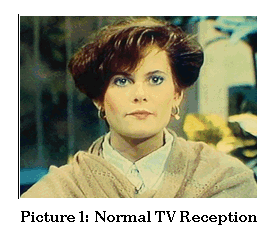 The
following pages illustrate what many common types of interference look like on a
TV set. Find the one that best matches your interference.
The
following pages illustrate what many common types of interference look like on a
TV set. Find the one that best matches your interference.
Use this picture for comparison with the other pictures in this section.
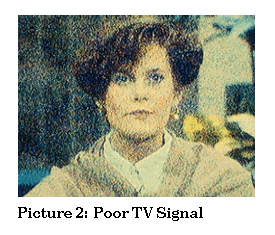 TV stations
are intended to serve viewers only within a limited distance of their
transmitters. You can improve picture quality by raising your antenna or using a
more directional antenna. Check your antenna line and connections. Try
reorienting your antenna for better reception. If necessary, consider installing
an outdoor antenna or a booster amplifier. Changing from flat twin lead to
round, coaxial cable may also help.
TV stations
are intended to serve viewers only within a limited distance of their
transmitters. You can improve picture quality by raising your antenna or using a
more directional antenna. Check your antenna line and connections. Try
reorienting your antenna for better reception. If necessary, consider installing
an outdoor antenna or a booster amplifier. Changing from flat twin lead to
round, coaxial cable may also help.
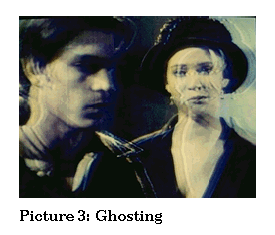 Double images
of a TV program, or "ghosting", is a common problem with off-air TV reception in
urban areas. Ghosting may be caused by the TV signal being reflected off of a
tall building or mountains. Ghosting may also indicate problems with the TV
antenna or lead in wire. Reorient your antenna, or install a shielded (coaxial)
lead in wire. You may need to install a directional, outdoor antenna.
Double images
of a TV program, or "ghosting", is a common problem with off-air TV reception in
urban areas. Ghosting may be caused by the TV signal being reflected off of a
tall building or mountains. Ghosting may also indicate problems with the TV
antenna or lead in wire. Reorient your antenna, or install a shielded (coaxial)
lead in wire. You may need to install a directional, outdoor antenna.
 Images from
two different programs may appear on your TV screen when your set simultaneously
receives two TV signals. Co-channel interference looks much like ghosting,
except that the two images are different, as though one picture has been placed
on top of the other. If the problem is caused by atmospheric conditions, it is
usually temporary. Installing a directional, outdoor antenna, or relocating your
indoor antenna may improve reception. You may also have similar interference if
you are picking up signals leaking from a cable TV system. If you believe that
you are picking up cable TV stations but you are not connected to the cable
system, contact the cable TV company.
Images from
two different programs may appear on your TV screen when your set simultaneously
receives two TV signals. Co-channel interference looks much like ghosting,
except that the two images are different, as though one picture has been placed
on top of the other. If the problem is caused by atmospheric conditions, it is
usually temporary. Installing a directional, outdoor antenna, or relocating your
indoor antenna may improve reception. You may also have similar interference if
you are picking up signals leaking from a cable TV system. If you believe that
you are picking up cable TV stations but you are not connected to the cable
system, contact the cable TV company.
 This picture
may appear on your TV screen when your set is reacting to signals from a CB,
amateur, police, or other two-way radio transmitter. The pattern will appear
only when the operator transmits. The "lines" in the interference pattern may be
wider, or may seem to "roll" up through the TV picture. If your TV is reacting
to CB or amateur radio transmissions, you will often hear the operator's voice,
although it may be garbled. If you are very close to the transmitting antenna,
the TV screen may "black out" when the operator transmits. It is also very
common to pick up the CB or amateur operator's voice on the telephone or on your
radio or stereo system. For information about possible remedies see Section III.
This picture
may appear on your TV screen when your set is reacting to signals from a CB,
amateur, police, or other two-way radio transmitter. The pattern will appear
only when the operator transmits. The "lines" in the interference pattern may be
wider, or may seem to "roll" up through the TV picture. If your TV is reacting
to CB or amateur radio transmissions, you will often hear the operator's voice,
although it may be garbled. If you are very close to the transmitting antenna,
the TV screen may "black out" when the operator transmits. It is also very
common to pick up the CB or amateur operator's voice on the telephone or on your
radio or stereo system. For information about possible remedies see Section III.
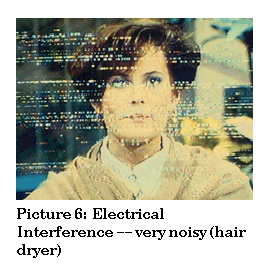 This picture
may appear on your TV screen when your set is reacting to an electrical device
operating in or near your home. Home appliances and electrical equipment, such
as hair dryers, electric razors and electric drills may cause temporary
problems. You may choose to live with this type of interference as it is often
expensive to correct. You may also experience intermittent problems from other
home appliances, such as refrigerators and air-conditioners. For example, you
may notice interference on your TV when your air conditioner cycles on or off.
If the interference is on continuously, it may be caused by power line
equipment. For information about possible remedies, see Section III.
This picture
may appear on your TV screen when your set is reacting to an electrical device
operating in or near your home. Home appliances and electrical equipment, such
as hair dryers, electric razors and electric drills may cause temporary
problems. You may choose to live with this type of interference as it is often
expensive to correct. You may also experience intermittent problems from other
home appliances, such as refrigerators and air-conditioners. For example, you
may notice interference on your TV when your air conditioner cycles on or off.
If the interference is on continuously, it may be caused by power line
equipment. For information about possible remedies, see Section III.
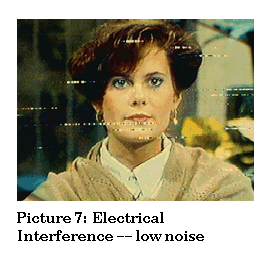
Doorbell transformers are a common source of interference to TV reception. This interference looks like snow or bars on the TV screen. It looks very much like electrical interference, except it does not cover the whole screen. It appears as bars of electrical interference. A frying or sizzling sound comes and goes at about seven second intervals (the intervals may vary). The interference may also be received hundreds of feet from the source. If you suspect that you are experiencing interference from your own or your neighbor's doorbell transformer, and are unable to locate the transformer, you may wish to contact a service technician.
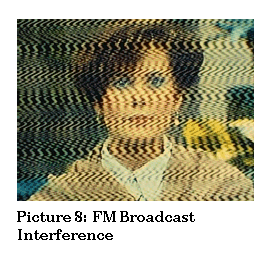 This pattern
may appear on your TV screen if you are picking up signals from an FM broadcast
transmitter. For information about possible remedies, see Section III.
This pattern
may appear on your TV screen if you are picking up signals from an FM broadcast
transmitter. For information about possible remedies, see Section III.
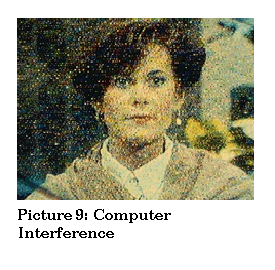
This type of picture may appear on your TV screen if you operate a computer in close proximity to the TV antenna. The interference may look like electrical interference or a series of diagonal dashed white lines among other patterns. Computer interference will usually occur only when the computer is very close to the TV antenna. You may try to reorient your antenna or computer cables, or move the computer or TV set to another location. For information about possible remedies, see Section III.
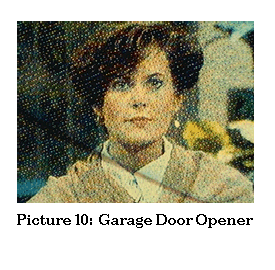 Low power
radio devices, such as garage door openers also can cause interference. This
pattern may appear on your screen, if you are picking up signals from a garage
door opener or radio frequency doorbell.
Low power
radio devices, such as garage door openers also can cause interference. This
pattern may appear on your screen, if you are picking up signals from a garage
door opener or radio frequency doorbell.
Booster amplifiers are often used to help receive weak or distant TV signals. Booster amplifiers may be installed at the TV set, at the TV antenna, or even in the attic. Although booster amplifiers do increase the TV station signal strength, they may also cause interference to your TV or even your neighbor's TV. A variety of patterns may appear on your TV screen because of booster amplifier interference. Sometimes a wavy pattern may appear, or the screen may black out for a short time. If your antenna system uses a booster amplifier, you should disconnect it and turn it off. Next connect your antenna directly to the TV. If the interference disappears, have your booster amplifier repaired or replaced. If you still have interference after disconnecting your booster amplifier, you may be receiving interference from a neighbor's amplifier. If several of your neighbors have interference, the one with the most severe interference is probably the one with the defective amplifier.
Amplifiers may also generate interference when used near strong signal sources, such as TV and radio broadcast stations, paging transmitters, or two- way radio stations.
c. Summary of Possible Interference Sources
1) Broadcast
2) Two-way Radio Transmitters
3) Paging Transmitters
4) Cable TV
5) Electrical Devices
III. Remedies
WARNING - - TO AVOID ELECTRICAL SHOCK, ELECTRIC OR ELECTRONIC EQUIPMENT SHOULD BE MODIFIED ONLY BY QUALIFIED SERVICE TECHNICIANS
Before you attempt any of the following solutions, you should see if moving or reorienting the affected device eliminates the interference. This often will prove to be a simple, but effective solution. For example, you may notice that your living room TV has perfect reception, while the bedroom TV has horrible interference. The farther away the affected device is from the interference source, the less severe the reaction will be.
If you believe that you are picking up interference through connecting cables or the antenna lead, you may wish to wrap several turns of the cable through a snap- together ferrite core.
It is always best if the affected device is modified in your home while it is reacting to the interference. This will enable the service technician to determine where the interfering signal is entering the equipment.
A. OFF-AIR or CABLE TV RECEPTION PROBLEMS
If you have reception problems such as a weak TV signal, ghosting, or co-channel interference, see Section II.B.3.b of this booklet.
B. TWO-WAY RADIO INTERFERENCE
The steps listed below may help you to eliminate TV interference that you experience from CB, amateur or other two-way radio stations. High-pass filters, common-mode chokes (choke filters), snap-together ferrite cores and ac-line filters are available from local electronics and department stores. A list of sources of filters is also provided at the end of this book. Remember, if your TV set or VCR has insufficient filtering or shielding, you may not be able to correct the interference yourself. You will have to obtain help from the manufacturer.
1. CB or Amateur Interference: Check to see if the TV volume control affects the interference level. If it does, install a "high-pass filter" at the antenna leads. This is a filter which will not allow signals in the the low part of the radio spectrum to pass through it. The name "high pass filter" is all you need to know to purchase one. If the TV volume control has no effect on the interference level, go to step 4. If you still receive the interference after installing a high-pass filter, go to step 3.
2. Two-way FM Interference: If you are receiving two-way FM transmissions, such as police or taxi, you may need to install a "notch" or "band-reject" filter at the TV antenna leads. The filter must be designed to reject the specific transmissions that you are receiving. The electronics dealer where you purchase the filter should be able to assist you with your selection. If you still receive the interference after installing a notch filter, continue to the next step.
3. Install a common-mode filter (see list) and/or common-mode choke at the TV input. If you still receive the interference, go to the next step.
4. Disconnect the antenna lead from the TV set. If you still have the interference with the antenna disconnected, install an ac- line filter at the electrical outlet your TV is plugged into.
Try wrapping three or four turns of the TV set's power cord through a ferrite core. Do this as close to the TV set as possible. You may also install a ferrite core on the antenna coaxial cable where it enters the TV set. You local electronics store will know what a ferrite core is and willl help you select one.
C. FM BROADCAST INTERFERENCE
There are three common interference problems that involve FM broadcast stations. The first problem may arise when you are receiving a distant TV signal and a new FM station begins operating in your area. The FM signal may overpower the weak TV signal. This problem often shows up as interference to TV channel 6 only. FM stations may also cause interference to radio receivers in your home.
The second problem is called "blanketing." It occurs when electrical or electronic devices are very close to the transmitter and where the FM signal is very strong. Operators of new FM stations are required to respond to all reasonable interference complaints in the immediate vicinity of the station. If the station is more than a year old or you live outside of the protected area, installation of an FM broadcast band rejection filter at your TV and/or stereo receiver antenna input leads, as well as use of a highly directional antenna may reduce your problem. You may also wish to reposition the location of your equipment to attempt to minimize or eliminate the problem(s).
Third, problems may occur when you are using an amplifier. Amplifiers are devices used to increase signals from distant stations and frequently react to strong nearby signals. If you suspect this is the case, you should install an FM band rejection filter or a tunable FM rejection trap in the antenna line between your antenna and booster. Some booster amplifiers have built in filters you simply switch on or off. Consult the instruction manual of your product. In extreme cases it may be necessary to install a second filter. Repair or replace your booster amplifier if it is defective.
D. PAGING SYSTEM INTERFERENCE
You may hear tones or voice transmissions from a one-way paging system coming through your TV set. The FCC requires paging system operators to assist in resolving interference caused by their transmissions only while the paging system is in the developmental licensing process. This is usually only within the first year of operation. Further, the FCC requires paging companies to resolve all interference complaints they may cause to television channels 4 and 5. If you know who the paging operator is, you may contact them directly. A band-reject, or "notch" filter designed to reject the paging frequency may be installed at the TV set input. If you need further assistance, you can contact your local FCC office listed in this handbook.
E. INTERFERENCE TO VIDEO CASSETTE RECORDERS (VCRs):
Your VCR is really a television receiver without a screen. If your VCR is receiving interference, replacing connecting wires with shielded wire (coaxial cable) or replacing push- on connectors with screw-on connectors may solve the problem. The solutions for interference from two-way radio, broadcasting, and paging, described for television interference above, also apply to VCR interference. If these do not work, contact the VCR manufacturer for alternative solutions.
F. COMPUTER INTERFERENCE:
Computer interference will normally disrupt only your TV reception. Check all computer connecting cables. You should especially be on the lookout for loose or unterminated cables. Greater distances between the TV and computer may solve the problem.
Occasionally, your computer may cause interference to your neighbor's TV reception. If this happens, you are required to discontinue using your computer system until you can eliminate the interference problem. Consult your owner's manual, the computer dealer, or the manufacturer for suggestions on how to resolve the interference.
G. TELEPHONE EQUIPMENT INTERFERENCE:
Telephone interference generally happens because telephones are not designed to operate near radio transmitters and the telephone improperly operates as a radio receiver.
You may contact the nearest FCC Office and request FOB Bulletin No. 10, "Telephone Interference". You may also try the following:
1. Contact the telephone company if you are using a leased phone. The telephone company may have responsibility for correcting interference to their leased phones.
2. Disconnect all of your telephones and accessories such as answering machines and take them to one telephone jack. Connect each instrument, one at a time, and listen for the interference. If you hear the interference through only one telephone, the interference is being generated in that unit.
3. Install a filter on the telephone line cord at the end nearest the telephone and/or at the telephone handset cord.
Filters are very selective. (See Section IV.) They must be designed for the type of interference your are experiencing or they will not work. For example, if your phone is reacting to an Amateur or a CB radio transmitter, install a filter designed for that purpose. FM broadcast interference requires a filter designed to reject FM broadcast stations. AM broadcast interference requires a filter designed to reject AM broadcast stations, etc.
4. Filter the incoming telephone line with ferrite beads and snap-together ferrite cores. You may need to experiment to find the best style of bead or core and the best location on the cord.
5. If you cannot eliminate the interference using the above techniques, you should consider purchasing a interference free telephone which has been specifically designed to be immune to interference.
Cordless telephones use radio frequencies and have no FCC protection from interference. If you are receiving nearby transmissions on a cordless phone your only recourse is to contact the manufacturer for assistance. The remedies above will not be of any use.
H. ELECTRICAL INTERFERENCE
If you have determined that the electrical interference is coming from within your home or one of your neighbor's homes, you should disconnect the defective equipment and replace it or have it repaired.
Devices such as electric razors, hair dryers, electric drills and saws can also cause temporary interference problems. You may choose to tolerate this type of interference since it is temporary and often expensive to eliminate. You may wish to contact the manufacturer for assistance.
If you determine that the interference is not caused by any device in your home, or a neighbor's home served by the same transformer, contact the service department of your local power company. Most power companies will investigate the problem and take steps to correct it.
I. INTERFERENCE TO OTHER EQUIPMENT
Stereos, electronic organs, and intercom devices, among others, can react to nearby radio transmitters. When this happens, the device improperly functions as a radio receiver. You should first determine what type of interference you are receiving. See Section II of this bulletin for assistance. You may try to relocate the device within your home. It is usually impractical or expensive to modify the affected device. Contact the manufacturer for assistance or consider changing to another brand or model.
IV. About filters:
Most filters are very selective. A filter designed to eliminate AM broadcast signals will have no effect upon an FM broadcast signal. Choose a filter designed for your needs. If you have doubts contact the manufacturers listed below to find a filter appropriate to your needs.
A. High pass filters
Channel Master . . . . . . . .Several Models
Industrial Park
Dr.
Smithfield NC 27577
(919) 934-9711
Cornel Dublier Electronics
1605 E. Rodney French Blvd
New Bedford, MA
02741
(617) 996-8561
Industrial Communications Engineers . . .Model 430 series high-pass
P.O.
Box 18495
Indianapolis, IN 46218-0495
(317) 545-5412
N6YHY TVI Filters . . . .Model YAK-plus TVI filter
928 Yellow Brick
Road
Modesto, CA 95351
(209) 531-1236
Radio Shack . . .Catalog: 15-579 for coaxial cable; 15-582 or 15-581 for twin
lead systems
Ten Tec . . . .Model 5060
1185 Dolly Parton Parkway
Sevierville, TN
37862
(615) 453-7172
Winegard . . . . . Model HP-2700
3000 Kirkwood Street
Burlington, IA
52601 1007
B. Common mode filters
Industrial Communications Engineers
P.O. Box 18495
Indianapolis, IN
46218-0495
(317) 545-5412
N6YHY TVI Filters . . . . Model Gorilla TVI Choke
928 Yellow Brick
Road
Modesto, CA 95351
(209) 531-1236
Starplex Inc. . . . . Model Ghost Buster dual-ferrite Choke
1912
Falcon
Hanley Hills, MO 63133
(314) 423-5756
TCE Labs . . . . Model # BX#2S
RR9 Box 243D
New Braunfels, TX
78133
(800) KILL TVI
C. Notch filters (band reject filters)
Notch filters are very selective. To be effective notch filters must be tuned to the frequency of the offending transmitter. Therefore your service technician or the manufacturer should do the installation.
Communications and Energy Corporation . . . . channel reject traps
7395
Taft Park Dr.
East Syracuse, NY 13057
(315) 452-0709 FAX (315)
451-0732
Microwave Filter Company
6743 Kinne St.
E. Syracuse, NY 13057
RMS Electronics
621 Route 46
Hasbrouck Heights, NJ 07064
(201)
288-8833
Star Circuits
P.O. Box 94917
Las Vegas, NV 89193
(800) 433-6319
US Electronics
600 D No Bicycle Path
Port Jefferson, NY 11776
Winegard . . . . Model UT-2700 notched between 4700 and 800 Mhz; BF-1700
attenuate 110 -170 Mhz
3000 Kirkwood St.
Burlington, IA 52601-1007
D. Ferrites and beads
Amidon, 2216 E Gladwick St.
Dominguez Hills, CA 90220
(310) 763
5770
Fair-Rite Products Corp. . . . Call to locate nearest distributor
Division
of Dexter Magnetic Materials
10 Fortune Drive
Billerica, MA
01865
(800) 345-4082
Kilo-Tec
P.O. Box 10
Oakview, CA 93022
(805) 646-9645
MFJ
P.O. Box 494
Mississippi State, MS 39762
(601) 323-5869
Ocean State Electronics
P.O. Box 1458
Westerly, RI 02991
(800)
523-0667
Palomar Engineers
P.O. Box 462222
Escondido, CA 92046
(619)
747-3343
Radio Shack . . . . Catalog # 273-105 and 273-104
E. AC line filters
Industrial Communications Engineers . . . . Model 472 isolator
P.O. Box
18495 Model 400 series
Indianapolis, IN 46218-0495
(317) 545-5412
Radio Shack . . . . Catalog: 15-1111 brute force AC line filter; 26-1395
surge-protection filter
TCE Labs . . . . Model KW-1
RR9 Box 243D
New Braunfels, TX
78133
(800) KILL-TVI
F. Telephone filters
AT&T . . . . Model Z100B1
(800) 222-3111
Coilcraft
1102 Silver Lake Road
Cary, Il 60013
(800) 322-2645
Engineering Consulting . . . . Model TRIF
583 Candlewood St.
Brea, CA
92621
(714)671-2009
Industrial Communications Engineers . . . . Model 460 series
P.O. Box
18495
Indianapolis, IN 46218-0495
(317) 545-5412
K-Com . . . . Model RF-1 for modular phones; RF-2 for wired phone
connections
P.O. Box 83
Randolph, OH 44265
(216) 325-2110
Kilo-Tec . . . . Model KT-RTK
P.O. Box 10
Oak View, CA 93022
(805)
646-9645
Richard Measures
6455 LaCumbre Road
Somis, CA 93066
(805)
482-3034
N6YHY TVI Filters . . . . Model Zebra telephone filter
928 Yellow Brick
Road
Modesto, CA 95351
(209) 531-1326
Southwester Bell Freedom Phone Accessories . . . . Model ZM04223
7486
Shadeland Station Way
Indianapolis, IN 46256
(317) 576-6847
Sparrevohn Engineering . . . .
Fred Sparrevohn
Sparrevohn
Engineering
6911 E. 11th St.
Long Beach, CA 90815
(562) 799-1577 or
(949) 642-7323
Web Site: Sparrevohn
Engineering Home Page
Long Beach, CA 90803
(714) 642-7323
(310) 433-7240
TCE Labs . . . . Model TP05301 Single line modular; TP-5302 two line
modular
RR9 Box 243 D New Braunfels, TX 78133
(800) KILL-TVI
Telecom Industries . . . . Model 831-W1
1385 Akron St.
Copiage, NY
11726
(516) 789-5020
G. Interference resistant telephones (These are much less susceptible to interference than others, but we do not guarantee they will receive no interference.)
PRO Distributors
2811-B
74th St.
Lubbock, TX 79423
(800)
658-2027
TCE Labs . . . . Model TXPL One line wall or desk phone; TPXL-2D Two line
Desk phone
RR 9 Box 243D
New Braunfels, TX 78133
(800) KILL-TVI
V. MANUFACTURER LIST
Some manufacturer mailing addresses and contact points are listed below. It is suggested that you provide the model number of your device, the serial number, and any information concerning the specific problem.
For listings of consumer electronics manufacturers not provided in this book, you may want to contact the Electronics Industry Alliance/Consumer Electronics Group, 2500 Wilson Boulevard, Arlington, VA 22201 (703) 907-7600.
BANG AND OLUFSEN OF AMERICA
Customer Service Department, tel. 1 800 323-0378
CARVER CORPORATION, INC.
20121 48th Avenue, Lynnwood, WA 98046, tel. (206) 775-1202
CONCORD (A HARMAN INTERNATIONAL COMPANY)
80 Crossways Park West, Woodbury, NY 11797, attention: Customer Service, tel. (516) 496-3400
CONN KEYBOARDS, INC.
Contact your local Conn dealer or Organ Service Department, P.O. Box 352, French Lick, IN 47432, tel. (812) 836-9200
CONRAD-JOHNSON DESIGN, INC.
2733 Merrilee Drive, Fairfax, VA 22031, tel. (703) 698-8581
CROWN INTERNATIONAL
Technical Services Department, 1718 W. Mishawaka Rd., Elkhart, IN 46517, tel. (219) 294-5571
CURTIS MATHES
Contact your retail-dealer or write to Consumer Relations Division, 1220 Champion Circle, Suite 100, Carrolton, TX 75006.
DEFINITIVE TECHNOLOGY, INC.
Anne Conaway, Definitive Technology, Inc., tel. (410) 363-7148
DELCO ELECTRONICS (DIVISION OF GM CORPORATION) SEE GM CORP.
P. O. Box 9005, Kokomo, Indiana 46904-9005, Attention: Steve Butler
tel. (317) 451-3372
EMERSON RADIO CORPORATION
9 Entin Road, Parsippany, NJ 07054, Attention: Mr Jim Flatt, tel. (201) 428-2125.
EPI (A HARMAN INTERNATIONAL COMPANY)
80 Crossways Park West, Woodbury, NY 11797, Attention: Customer Service, tel. 1 800 343-9381.
EPICURE PRODUCTS, FORMERLY ELPA MARKETING INDUSTRIES, INC.
Mr. Jim Orman, National Service Manager, 25 Hale St., Newburyport, MA 01950, tel. 1 800 225-7932
FANNON COURIER CORPORATION
Mr. Mike Santana, Vice President of Engineering, 15200 San Fernando Mission Blvd., Mission Hill, CA 91345, tel. (213) 365-2531.
GENERAL ELECTRIC COMPANY
Consumer Relations Department, Mail Drop 43, Consumer Electronic Business Operations, Portsmouth, VA 23705, tel. (804) 483-5652.
GENERAL MOTORS CORPORATION
Seek assistance at your GM dealership or contact Steve Butler of Delco Electronics, Subsidiary of GM Hughes Electronics, P.O. Box 9005, Kokomo, Indiana 46904-9005, tel. (317) 451-3372.
H.H. SCOTT, INC.
9 Entin Road, Parsippany, NJ 07054. Attention: Mr. Jim Flatt, tel. (201) 428-2125
HARMAN/KARDON, INC.
80 Crossways Park West, Woodbury, NY 11797, Attention: Customer Service, tel. 1 800 422-8027 or 1 800 343-9381 (video division).
HITACHI HOME ELECTRONICS (AMERICA), INC.
Customer Service Relations, 3890 Steve Reynolds Blvd., Norcross, GA 30093, tel. (404) 279-5600, extension 22 or contact Mr. Chris Fabian, National Service Manager, ext. 145, 9am-5pm EST, M-F.
JBL CONSUMER PRODUCTS, INC.
80 Crossways Part West, Woodbury, NY 11797, Attention: Customer Service, tel. 1 800 336-4JBL (4525), or contact JBL Consumer Products, Inc., Mike Christian, tel. (516) 496-3400, Ext. 233.
LONESTAR TECHNOLOGIES, LTD.
920 South Oyster Bay Road, Hicksville, NY 11801, Attention: Arlene Vittore, tel. (516) 939-6116
MAGNAVOX (SEE PHILIPS CONSUMER ELECTRONICS COMPANY)
MARANTZ AMERICA, INC.
Marantz America Service Department, 440 Medinah Road, Roselle, IL 60172-2330, tel. (708) 307-3100, fax (708) 307-2687
MITSUBISHI ELECTRONICS AMERICA, INC.
Consumer Relations Department, tel. (714) 220-1464
NAIM AUDIO NORTH AMERICA, INC.
1748 North Sedgwick Street, Chicago, IL 60614, tel. (312) 944-0217, fax (312) 944-0255
NINTENDO OF AMERICA INC.
4820 150th Ave NE, Redmond, WA 98052, tel. 1 800 255-3700, hrs 4AM -Midnight PST, M-Sat, 6AM - 7PM, PST on Sundays. Contact is Dorothy Caravias tel. (206) 861-2796
PANASONIC (MATSUSHITA ELECTRIC CORPORATION OF AMERICA)
One Panasonic Way 2F-3, Secaucus, NJ 07094, Attn: Customer Satisfaction Center, tel. (201) 348-9090
PHILCO - (SEE PHILIPS CONSUMER ELECTRONICS COMPANY)
PHILIPS CONSUMER ELECTRONICS COMPANY/PHILIPS ELECTRONICS NORTH AMERICAN COMPANY
Dick Hovermale, Information and Consumers Affairs Center, 401 E. Old Andrew Johnson Highway, P.O. Box 555, Jefferson City, TN 37760, tel. (615) 475-8869 or (615) 475-0063, fax (615) 475-0203
QUASAR (MATSUSHITA ELECTRIC CORPORATION OF AMERICA)
50 Meadowland Parkway 2F-3, Secaucus, NJ 07094, Attention: Customer Satisfaction Center, tel. (201) 348-9090
ROTEL OF AMERICA
J. Laliberte, National Service Manager, P.O. Box 8, North Reading, MA 01864-0008, tel. (508) 664-3820
SONY ELECTRONICS INC.
Sony Customer Relations Center, One Sony Drive, Park Ridge, NJ 07656, tel. 1 800 282-2848 or Technical Services Department, tel. (201) 930-1000
THOMSON CONSUMER ELECTRONICS
Larry Elkin, Thomson Consumer Electronics, P.O. Box 6127, INH-315, Indianapolis, IN, tel. (317) 231-4151
TOSHIBA AMERICA CONSUMER PRODUCTS, INC.
National Service Division
1420B Toshiba Drive
Lebanon, TN 37087
Ph: (615)449-2360
Fax: (615)444-7520
VEHICLE SECURITY ELECTRONICS, INC.
Rudy Sanders, President, 21540-F Prairie Street, Chatsworth, CA 91311, tel. (818) 700-7900, fax (818) 700-7926
VIDEONICS, INC.
Videonics' Help Line, 1370 Dell Ave., Campbell, CA 95008, tel. (408) 370-9963; 8am - noon and 1pm - 5pm, Pacific Time
WADIA DIGITAL CORPORATION
Service Department, 624 Troy St., River Falls, WI 54022, tel. (715) 426-5900
YAMAHA ELECTRONICS CORPORATION, USA AND YAMAHA CORPORATION OF AMERICA
Mr. Bill Bower, Electronic Service Manager, Electronic Service Department, 6600 Orangethorpe Ave, Buena Park, CA 90620, tel. (714) 522-9100.
TELEPHONE MANUFACTURER CONTACTS
AT&T National Sales and Service Center
(800) 222-311
Cobra Comm
(800) 262 7222
Code-A-phone
(503) 655 8940
Fun Products
(415) 540-0334
General Electric
(800) 447-1700
ITT - Technical Assistance
(601) 287-5281
Lonestar
(516) 939-6116
Northern Telecom
(919) 992-5743
Pac Tel
(800) 426-2372
Panasonic Consumer Electronics
(800) 221-3438 ext. 6881
Phonemate
(800) 247-7889
(213) 320-9810
Plantronics
(800) 538 0748
(800) 662-3902 CA
Sanyo
(800) 524-0047 ext. 502 or 520
Soundesign Corporation
(201) 434-1050
Swisstel
(201) 470-5706
TOSHIBA AMERICA CONSUMER PRODUCTS, INC.
National Service Division
1420B Toshiba Drive
Lebanon, TN 37087
Ph: (615)449-2360
Fax: (615)444-7520
TT system
(914) 968-2100
Uniden Corp.
(317) 842-2483